Azalea Tree Bonsai | Ultimate Species Care Guide
The Azalea tree bonsai is an incredibly beautiful species, and it will be the wonder of anyone who beholds it in your house. However, there are specific requirements you need to be aware of if you want to care for the Rhododendron properly.
We’ve prepared the ultimate guide for caring for your Azalea bonsai.
Table of Contents
Quick Caresheet For Azalea Tree Bonsai
We’re about to step into a detailed discussion about Azalea bonsai care. Before we do, here’s a TL;DR for an overview of the facts you need to know.
Recommended soil
Equal parts pumice, humus, and akadama
Watering
Summer: daily; winter: 2 – 3 times a week
Potting season
Early to late spring after flowering, every two years
Shaping and pruning season
Spring: shaping; summer: pruning
Light
Four hours of sunlight every morning, shaded rest of day
Humidity
High levels needed
Fertilizing
Spring: inorganic fertilizer every two weeks; summer every month; winter: never
Propagation methods
Cuttings in summer and spring
Pests and diseases
Aphids, mites, vine weevil, leaf galls, root rot
Growth patterns
Vigorous foliage and flower growth, the dense root system
Recommended styles
All styles except root-over-rock
Native area
Asia, Northeastern United States
Azalea Scientific Classification
- Class: Asterids
- Order: Ericales (heath)
- Family: Ericaceae (heath)
- Genus: Rhododendron
- Subgenus: Azaleastrum (Azalea)
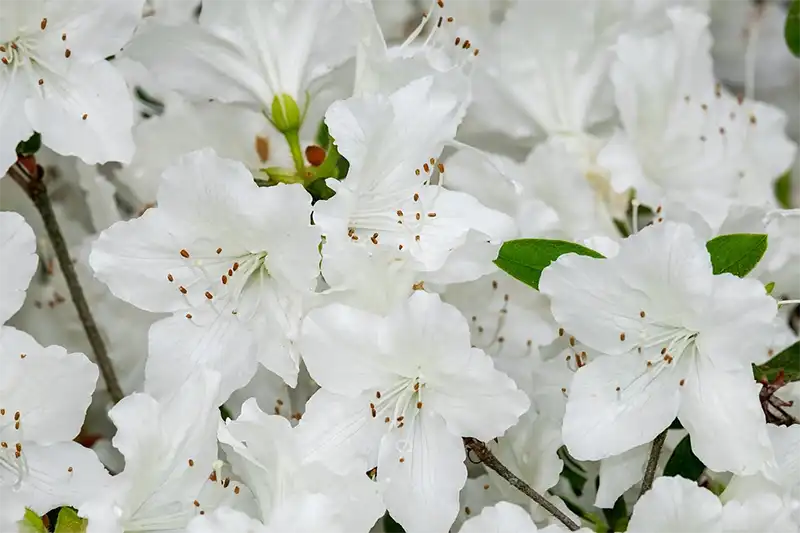
Do Azaleas Make Good Bonsai Trees?
When it comes to stunning, bushy foliage with beautiful flowers, you can’t get better than the Azalea tree bonsai. It has incredibly hardy features and will brighten any room. When you prune any of the branches, you can expect new shoots to appear shortly, which creates fantastic stratification.
The Azalea is a subgenus below Rhododendron, but many people use the latter name for the former interchangeably. Besides there being more than a hundred Azalea species, there are more than 10,000 cultivars found worldwide. You can develop a massive collection of these bonsais with so many varieties for an outstanding display.
Are Azalea Bonsais Good For Beginners?
As you’ll see in our Azalea tree bonsai care guide below, there are many aspects to consider before buying your first one. Fortunately, they are generally easy to maintain, so Azaleas do make good bonsais for beginners. As long as you follow our guidelines below, you shouldn’t have any significant issues.
Location
Let’s start our care guide for the Azalea tree bonsai with the right location. We know you’d love to bring it into your home to display the flowers, but is that the best idea? How will it affect your beautiful miniature landscape, and will it survive?
Let’s have a look at the various aspects you’ll need to consider.
Can Azalea Trees Be Planted Outside?
These plants love growing outside, especially a braided Azalea tree, as it gives them a chance to soak in the sun. The sunlight assists with producing flowers in summer, which is what you’d want for a bonsai. You also have the choice of letting it develop vigorously in the ground before planting it in a pot.
While it enjoys being outside, you may want to provide some protection from the elements at times. Strong winds may damage delicate branches on your Azalea bonsai tree. It also doesn’t enjoy frost, so ensure you place it in a greenhouse or indoors in winter.
Can Azalea Bonsai Grow Indoors?
There are some Azalea species that don’t do well inside, but generally, these bonsai trees can manage as long as there’s some direct sunlight for a few hours. It will still enjoy the light and produce flowers, while it has the added protection from the other elements.
It’s essential that you place it in a location that only gives morning and late afternoon sunlight, as you don’t want the leaves and flowers to burn. Also, you’ll need to ensure there’s enough humidity in the room. When frost arrives, indoor locations are ideal for the Azalea bush in winter.
Where Do Azaleas Grow Best?
The optimal conditions for Azalea bonsais to grow best are outside, as long as there’s a spot where they can receive some shade in the peak afternoon. You can use another tree as cover in the hottest part of the day, or maybe on the side of your house where it will mostly have morning light.
The walls can also act as a breaker against strong winds or rainfall, and we also recommend looking into a secure bonsai stand. You can use a wooden shelf to attach it to or look into tall racks for several of your trees that love morning light.
When Should You Plant An Azalea Bush?
The best time to plant your Azalea tree bonsai is in late spring just after the new shoots have settled, or in early autumn just before it goes into dormancy. The same rules apply for repotting after a few years. It helps protect the roots and foliage from any damage or stress and promotes new development when spring arrives again.
If you’re working with Azalea cuttings, you can take them in early spring after you see the new growth and place them in the medium of your choice. It works best with rooting powder, but you’ll need to remove the lower third of the leaves.
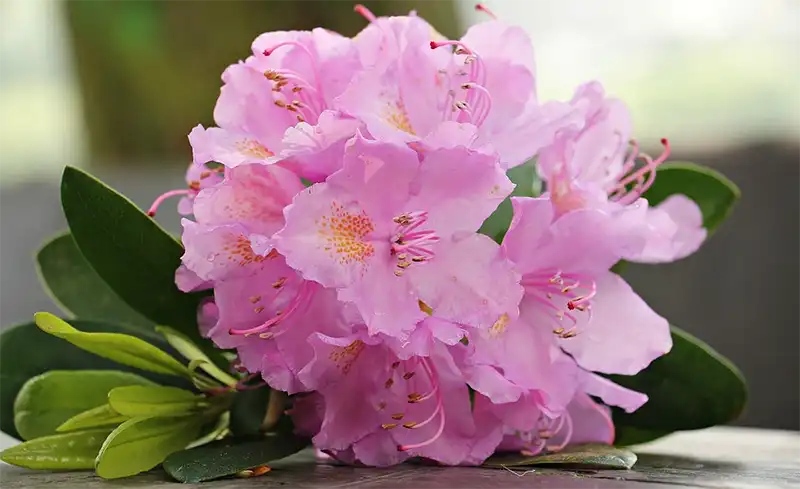
Azalea Flowers
The most outstanding feature of the Azalea bonsai tree is the flower. It looks absolutely gorgeous and there’s a wide variety of colors you can aim for. However, they sometimes struggle to bloom, while you can also help them along.
In this section, we’ll quickly focus on the flowers and how you can assist your bonsai tree in presenting an outstanding display.
How Often Do Azalea Bonsai Bloom?
For the most part, Azalea bonsais bloom once a year when the later winter turns into spring. You’ll see the first buds appear with the flowers right after, setting the scene for a gorgeous summer ahead. If you’re lucky, it will bloom for a second time when autumn arrives, as can be seen with the Satsuki Azalea.
The one significant factor of the blooms is when the flowers are pollinated. If you manage to grow some Azalea seeds, you have the chance to develop more bonsai trees like saplings. It’s up to you if you want to add them to your collection, place them in your garden, or sell them.
How Do I Make My Azalea Bonsai Bloom?
When you end up in a situation with your Azalea not blooming, you’ll need to check why and take corrective action. For the most part, the various species love the full sun during the morning, as this gives them the energy they need to produce flowers. Too much shade, and you won’t see much blooming. You’ll also need to shield it from too much rain and hot temperatures.
Another vital aspect of making your Azalea tree bonsai bloom is feeding it. You shouldn’t use a fertilizer with too much nitrogen, as that mineral is used to promote foliage development. With a good feeding schedule, watering, and sunlight, you’re sure to see your tree flower in no time, as long as it’s the right season.
How Do You Keep Azaleas Blooming?
The best way to keep your bonsai blooming is to promote Azalea flower care. The petals are incredibly delicate, and too much damage may cause them to stop developing further. The same rules apply to taking care of your tree with the guidelines mentioned above, but there are a few more tips you should note.
Pruning dead flowers is essential if you want the bonsai to keep blooming. They often sap the nutrients that they no longer need, and the tree can use it elsewhere with new buds. You’ll also need to watch out for pests and diseases that slow down flower formation.
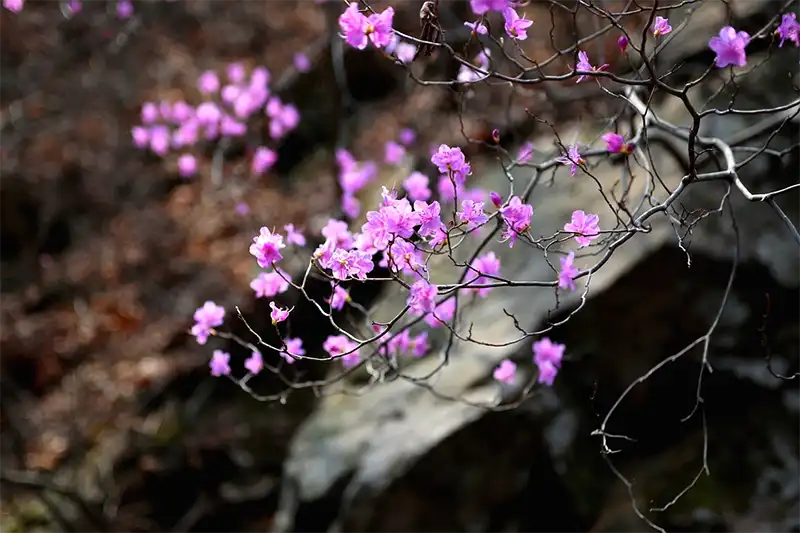
Azalea Tree Care
It’s time to look at the heart of the Azalea tree bonsai care. There are specific aspects you need to look at if you want to keep it alive. While some of these are easy to perform, there are other tasks that require more attention.
Here’s an overview of what care your Azalea bonsai needs.
How Do I Look After My Azalea Bonsai?
The key aspect to looking after your Azalea bonsai tree is ensuring that there are adequate Azalea growing conditions. What we mean is that you should make sure you don’t just apply the same generic rules for all plants. You’re setting yourself up for failure, and the tree may end up dying.
We’ve made an extensive list of aspects you need to consider here below. Pay attention to each of them to ensure you provide the proper care for your Azaleas. Also, make sure you read up on the specific species, as each one may have different needs.
How Much Sun Does An Azalea Bush Need?
Azalea and the sun go well together, and getting enough sunlight to your bonsai tree is a top priority. For the most part, they love the direct sun for a couple of hours in the day, and you can even leave them outside for most of the day.
You’ll need to watch that summer heat, though. When the sun is at its peak, it may burn the leaves and flowers, ruin what you’ve spent all of spring cultivating. Do yourself and the Azalea tree bonsai a favor and ensure that it receives some afternoon shade in this situation.
How Often Should You Water An Azalea Bonsai?
How regularly you water your Azalea bonsai depends on the season. When it’s spring and summer and the tree is in full growth, you’ll want to water once a day, maybe even twice. If there’s one factor that this genus hates is when the roots dry out.
In autumn, you can start slowing down the frequency. Ensure you feel the top 3 inches of the soil to see if it’s still moist. When your Azalea goes through a second blooming period, there’s a chance you still need to maintain the same watering patterns. In winter when it’s dormant, you can slow down to twice a week.
Do Azaleas Need A Lot Of Water?
Azaleas have shallow roots, so they won’t dig deep into the pot for water. While ensuring that there’s enough drainage, you can drown the soil in water in summer. The bonsai tree will take as much as it needs from the moisture that remains.
However, ensure that the soil doesn’t become soggy. With too much moisture at the bottom of the pot, it can cause mold and root rot. You can use drainage rocks as a bottom layer to prevent this while making sure there’s still sufficient liquid in the substrate. You can also use a water tray for it to drink out of.
How Do I Prune Azaleas?
Now’s the time to unleash your creative side. You can use Azalea bonsai pruning to develop various styles while also maintaining the foliage, flowers, and roots. How you prune the tree depends on whether you’re aiming for maintenance or design.
You can perform maintenance pruning in early summer and autumn. When done in summer, it promotes the health of the tree and prevents the bonsai from growing too tall too quickly. Doing so in autumn helps remove any dead buds and flowers and gives them a chance to bloom again. In winter, you can do design pruning to remove any branches you don’t want.
Can You Hard Prune Azalea?
Hard pruning Azalea tree bonsais can be done, as long as you don’t remove too many of the branches. The main idea is that you cut back branches where it meets the stem or other connections. This promotes new wood that’s stronger and healthier in the long run.
For branches that are less than 0.5 inches, you’ll need to use clippers, while anything larger requires loppers. You should sterilize any equipment you use; otherwise, it may cause infections and diseases in the rest of the tree.
What Kind Of Soil Do Azaleas Need?
When it comes to soil, Azalea bonsais tend to steer towards a more acidic taste, such as a pH level of 5.5. You should aim for a mixed substrate that drains well, such as compost, peat, ground bark, or chopped leaves. It doesn’t like clay, alkaline, or pure sand.
If something doesn’t look right and you need to fix the Azalea soil, you can add pine bark to the mix, as it will raise the acidic levels. You can also use acidic compost or rotten leaves, as these do well too. Finally, you can add nitrogen fertilizer if you want denser foliage, but then there may not be as many flowers.
How Do You Dig Up Azalea Roots?
Your Azalea roots will need some fresh soil now and again, which means you’ll need to report it. However, the roots are fine, so you stand a chance of breaking them when you dig them up. For the best method, you should make a trench all around the inside of your container.
This act will separate the soil and outer roots from the pot and make it easier to remove. You can now place the soil and roots in a tub of water and leave it there for about half an hour. The substrate will loosen, and you can more easily clean the roots before placing them in the new container.
How Do You Get Rid Of Powdery Mildew On Azaleas?
Azalea fungus is the last thing you want to see on your bonsai tree. It looks like small, powdery formations on the leaves and stem, and it can have a detrimental effect on the plant’s health. To get rid of the mildew, you’ll need to clean it off and eliminate the conditions that promote it.
For instance, mildew loves high humidity, dry foliage, moderate temperatures, and low light. So, if you regularly spray the leaves and provide bright sunlight, you shouldn’t have any issues. If you already have fungus on your Azalea tree bonsai, you should purchase an organic fungicide.
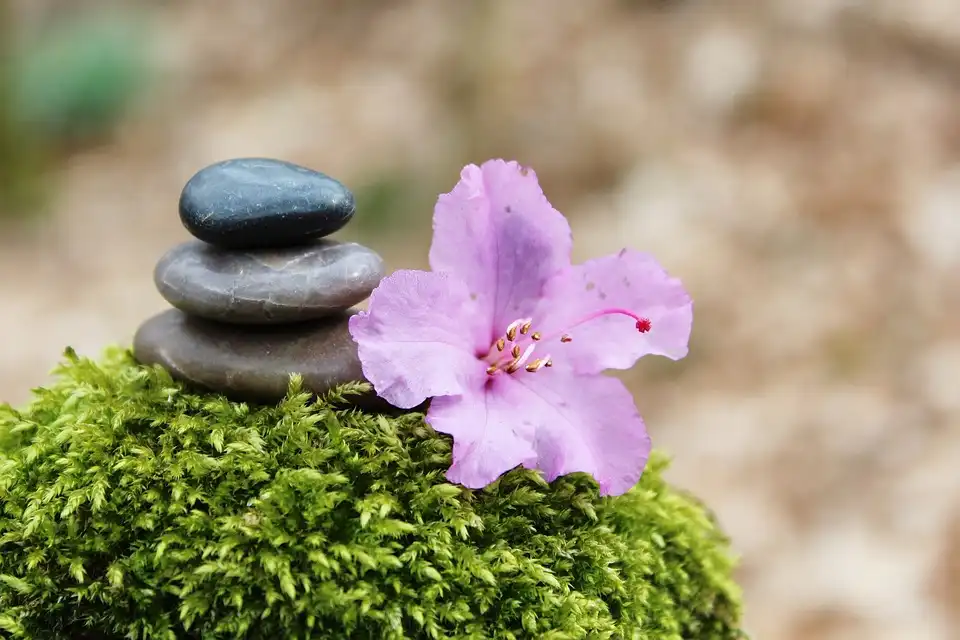
Feeding Your Azalea
While feeding your Azalea tree bonsai is part of caring for it, we’re going to treat it as a separate item. We have several facets we want you to pay attention to, which is why we have this section for it. Fertilizer will help your tree grow beautifully, but there are some warnings you need to consider.
How Do You Fertilize Azalea Bonsai Trees?
Azalea fertilizer helps your bonsai tree to develop properly in the growing season. It promotes new shoots and flowers, and you’ll see a stunning display. There are two types of feeders you can use, namely, liquid and solid.
The liquid form is concentrated, so you’ll need to dilute it with water in your watering can according to the instructions. There are various forms of solid fertilizer, such as pellets and spikes. They last longer than the liquid types, so you won’t need to use them as much.
What Is The Best Fertilizer For Azaleas?
Whichever fertilizer you decided to buy for your Azalea bonsai, you need to ensure that there’s sufficient NPK (nitrogen, phosphorous, potassium). The nitrogen levels promote foliage growth, so if that’s your intention, you can grab a ratio where the N is higher than the rest. If you just want standard growth, you can aim for a balanced approach, such as 15:15:15.
Of course, it helps to know the levels in the soil you currently have. If any of them are low, you need to opt for a different ratio. You can buy cheap testers to measure it. We also recommend checking the pH levels.
What Time Of Year Do You Fertilize Azaleas?
The best time of year to feed your Azalea tree is when the growth is at the maximum level. There are two periods you’ll need to look at. The first is late spring and early summer, as this is the first bloom. You’ll see vigorous blooming and leaves appearing.
The second period is late summer and early autumn when you see the second spurt of growth. Fertilizing in autumn also helps the Azalea bonsai store carbohydrates for the coming winter when it goes dormant. It’s at this point that you stop providing fertilizer.
When Should I Feed My Azalea Bonsai?
Your Azalea tree will show you signs of when it needs feeding. You may notice smaller leaves in summer despite no pruning, or the foliage may turn yellow and fall off. While this may be acceptable for winter, it isn’t for the growing period.
It’s best to feed your Azalea bonsai in the late evening or early morning. It will set the nutrients for the long day ahead when it needs to use the food to create energy. Don’t wait until the sun is at its highest before you remember the fertilizer.
Do Azaleas Like Coffee Grounds?
There are two aspects to consider when using coffee grounds with Azaleas. The first is that they add to the acidic levels, which is great if you’re dealing with soil that has neutral or alkaline levels. You can throw the grounds mixed with water to help move it in the right direction.
Secondly, you should be careful using coffee grounds with soil or fertilizer that has a high nitrogen level. The mixture tends to stunt the development of flowers and seeds, so you may not see many blooms in summer.
How Much Coffee Grounds Should I Put Around My Azaleas?
If you plan on using coffee grounds around your Azalea bonsai tree, you might want to look at adding it to compost instead of directly to the soil. The Environmental Protection Agency indicated that the coffee volume shouldn’t be more than 25%, as it may increase the acidic levels too much. The species love mulch made from compost, so the two work well hand-in-hand as an organic fertilizer.
Another recommendation is that you layer it on the outermost limits of the pot so that the roots can suck it up from the soil instead of direct feeding. It will keep the roots healthy and prevent any diseases or issues.
Is Epsom Salt Good For Azaleas?
One essential element for Azalea bonsai leaves is magnesium. If it’s lacking in the soil, you’ll see the foliage turn yellow and fall off, even if you have the acidic and nitrogen levels correct. To fix this problem, you add Epsom salts to the soil.
Another concern is that your soil may be high in phosphorous, which reduced the absorption of magnesium. If this is the case, don’t add Epson salts, as it won’t fix the problem. The optimal solution is to reduce the phosphorous levels in the soil, which will then promote magnesium intake by the roots.
Another issue with using Epsom salts is that many people place them in the soil to neutralize alkaline levels. If your substrate is already at the optimal acidic level, you shouldn’t use the salts at all, as it will lower the pH level too far.
Are Banana Peels Good For Azaleas?
As you’ve seen already, nitrogen plays an essential part in growing your foliage, but it stunts flower development. To combat this, potassium aids in making healthier blooms and balancing out the nitrogen intake. If you want to promote healthier flowers, you can use banana peels with your Azalea tree bonsai.
The best way to use them is to bury pieces of banana peels in the soil. As the organic compounds break down, it will improve the potassium levels in the soil naturally, so you won’t have to worry about chemical fertilizers. It will also strengthen the trunk and branches while defending against diseases. It also helps that the peels have no nitrogen.
Banana peels also provide the following nutrients and minerals:
- Manganese: Helps with photosynthesis
- Sodium: Assists water in flowing between cells
- Sulfur and manganese: helps create chlorophyll
Besides buying the banana peels, you can also soak them in hot water to make a tea that you can pour into the Azalea bonsai soil.
Are Eggshells Good For Azaleas?
Since we’re dealing with minerals and nutrients, let’s focus on calcium, which is a key component in eggshells. It aids in the formation and development of leaves and branches, while also preventing rot at the ends of flowers. It also helps Azalea bonsais absorb water, which assists when it’s incredibly thirsty in summer.
A neat trick you can use is to place the eggshells over some of the drainage holes. As they decompose, they release nutrients into the soil that make it more acidic. The calcium is then absorbed when the Azalea tree drinks, making it healthier and stronger.
In this way, any remains of the broken eggshells will filter out the drainage holes when they’re small enough. You can also crush the shells into powder and apply it to your watering can as a natural fertilizer.
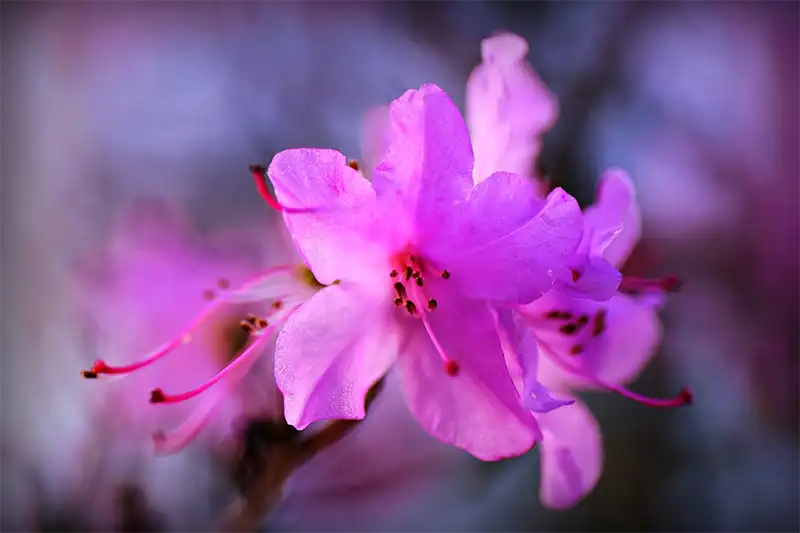
General Azalea Bonsai Guide
While we’ve covered most of the aspects of Azalea bonsai tree care, there are few general pieces of knowledge we want to share with you. Some of these may seem like trivia, but they do guide you when something seems to be going wrong.
Can Azaleas Grow Into Trees?
For the most part, they’re seen as bushes, as you won’t see one become a full grown Azalea tree in the wild. Many people keep them as low shrubs to complement borders or create stunning landscape designs. However, as bonsais are small, you can definitely train them to look like small trees.
You’ll need to decide on a design that doesn’t look like an Azalea shrub. We recommend upright broom, slanting, or you can even go for semi-cascading. The only issue is that you won’t be able to use trees in nature for inspiration, but there are plenty of bonsai images online you can turn to.
Another consideration is that they grow vigorously in spring and summer, so you’ll need to prune often to make your Azalea develop into a small tree. It may feel unnatural for some of the species, but you’ll see how quickly they adapt. If you want to have a small bushy design, there’s no reason you can’t as it will promote more flowers.
How Big Does An Azalea Tree Get?
How big an Azalea becomes depends on the species and purpose. If you just let it grow as it wishes, you can get them as tall as 20 ft. Ones used in gardens might only reach 6 ft., while Dwarf Azaleas are known for getting up to 3 ft., which are ideal for bonsais.
If you’re growing an Azalea tree bonsai, you can develop the dimensions up to 5 ft. tall by 5 ft. wide. Remember the match the pot’s shape with the foliage to give it that ideal symmetry. You can also cultivate a canopy to protect the soil from drying out in direct sunlight.
The size of the foliage will determine how many flowers you’ll see. The more branches you have, the more opportunities for blooming. You can also keep the Azalea size as small as you want, but it might not suit its fast-growing lifestyle.
Do Azalea Come Back Every Year?
Whether the Azalea comes back every year depends on several factors. The one is the species and the other how well you look after them. If you cut back in the middle of summer, you’re sure to see the second growth of leaves and flowers well into autumn.
While we’ve mentioned that the flowers won’t appear if the nutrients and sunlight aren’t correct, the same can be said about the leaves. If there isn’t sufficient acidity and nitrogen in the soil, the Azalea tree bonsai may refuse to develop new shoots.
It’s a careful balance you need to strike, but the bonsai will always give you signs if something is going wrong. If your Azalea doesn’t spring back the next year, you’ll need to look at which aspect looks unhealthy: the soil, foliage, flowers, or roots. There may even be some pests or diseases present.
What Is The Lifespan Of An Azalea?
On average, Azalea species live for up to 50 years. There have been cases where it’s been longer, but these are truly exceptional. When it comes to bonsai trees, they may only last as long as 35 years unless you have them growing in the ideal conditions.
The one aspect you need to look at is the Azalea growth rate. There are ways you can increase it, but it may not be a good idea as a bonsai. You’ll want to keep the leaves small so they don’t burden the branches with weight. How much you prune it every year during the winter period will also have an effect on how long it will live.
A final factor to consider is when the Azalea bonsai changes hands. If the tree outlives you, someone else will need to take care of it. It’s always good to share your passion with a friend or family member so they will be willing to look after it or sell it to someone who is.
Do Azalea Bonsai Lose Their Leaves?
Deciduous plants are the ones that lose their leaves in autumn, so you’ll be happy to hear that Azalea trees are evergreen. They’ll retain their green leaves throughout the winter. If your bonsai is losing its leaves, that means that there’s something wrong with it. There are a few species that have deciduous traits, though.
One of the more natural reasons the Azalea leaves may be falling is due to the change from winter to spring. It’s common for the species to drop the older foliage in favor of new growth.
However, here are some other reasons it may be happening:
- Too much water
- Drought-like conditions
- Alkaline or neutral soil
- Not enough nitrogen
- Too little sunlight
- Pests or diseases
Why Is My Azalea Bonsai Dying?
Many people feel their bonsai is dying when they see Azalea leaves turning yellow. While this may be one of the symptoms, you’ll need to get to the cause before making that assumption. Still, there may be various reasons why the tree is dying, such as watering, sunlight, incorrect nutrients, no fertilizer, or damaging pesticides.
One action you should avoid is moving it around too much trying to find the correct location. You’re causing it to stress out, which may ultimately lead to its death. You need to find a sunny spot where it’s protected from frost and wind and care for it like we’ve shown you thus far.
How Do I Revive My Azalea Bonsai Tree?
If you’d like to revive your dying Azalea tree bonsai, there are a few steps you can try. You should assess each task to see which ones are necessary, as we don’t encourage you to perform all of them. Also, you should give it a few months to recover before you declare it officially dead.
Here’s how to revive your Azalea bonsai:
- Prune any sections that look completely dead
- Look at the cambium of a branch or the trunk to see if there’s any green inside, which is an indicator of life
- Remove the roots and prune them
- Let the roots rest in a bowl of water for an hour
- Place new soil in a new container
- Repot your Azalea tree
- Place it in a sunny location with dappled shade in the afternoon
- Continue to water the soil without letting it dry out
- Play the waiting game
Are Azalea Bonsai Trees Poisonous To Cats?
Unfortunately, Azaleas are incredibly toxic to cats and other animals, specifically the leaves. If they ingest them, they can become sick. Some symptoms to look out for include twitching, weakness, bad coordination, respiratory distress, and inability to focus. While we know you can’t tell your cat where it can and can’t go, ensure that your bonsai is in a place where they are least likely to travel.
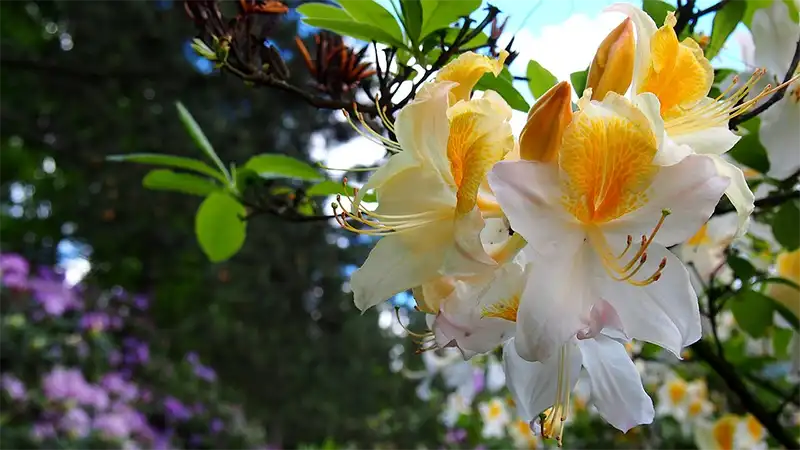
Final Thoughts
If you receive or buy an Azalea tree bonsai, you’re in for a wonderful journey with this small companion. We’ve seen a few festivals where the hosts put on stunning displays, and it really warms the heart to see the miniature tree at work. It works even better when you have several bushes in your garden and then take some cuttings to grow in a pot.
Whichever way you want to do it, we hope you share some photos with us. You can add it in the comments below, or tag us on Facebook, Twitter, or Instagram. We also have several posts we’ve shared on Pinterest related to the Azalea species, so ensure you keep a lookout on our feed.







